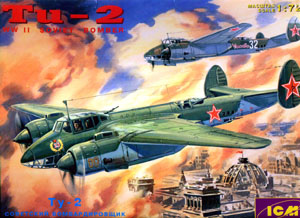History The TU-2 dive bomber (also used in a reconnaissance role) was one of the best known Soviet aircraft of the WWII period. The prototype made its maiden flight on January 29th, 1941. The first early production model entered combat in July of that year, over the Zapadny Front. Production commenced, until the end of 1943, with the 1850 hp ASH-82FN engines as powerplants. A total of 2,500 aircraft were produced, in various versions, when production finally ended in 1951. The TU-2C bomber was the basis for the TU-2R reconnaissance plane, the TU-2D long range bomber, and the TU-2T torpedo carrier and mine layer. Following the German surrender, in the west, the aircraft was successfully deployed against Japanese troops in China and also by the Soviet and Chinese Air Forces during the Korean war of 1950-1953. The TU-2 also flew in the Polish, Bulgarian, Yugoslavian, and Indonesian Air Forces. Tech Data Length: 13.8 m
Span: 18.88 m
Unloaded weight: 12,800 kg
Maximum Speed: 550 km/h
Ceiling: 9,500 m
Range: 2,500 km
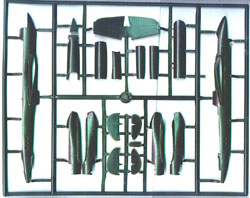 Armament: 2 x 20 mm shVAK cannons Armament: 2 x 20 mm shVAK cannons
3 x 12.7 mm UBS machine guns
Maximum Bomb Load: 3,000 kg The Kit The kit is packaged in a tray and lid type box. The box art shows two TU-2s over-flying a burning city. Inside the box is a single cello bag holding all four trees of parts. Three of these trees are in dark green styrene and the fourth is clear parts. Large tree, letter "A" holds wing halves, engine air intakes, cowlings, aerilons, oil cooler cowlings, propellors, three UB machine guns, pilot figure, navigator figure (26 parts). 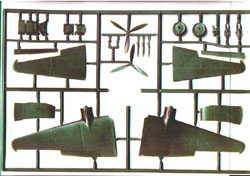 Large tree, letter "B" holds fuselage halves, bomb bay doors, fuselage belly panel, fuel tank cover, tailwheel doors, tailplane, fuselage tail tip, engine necelles (exteriors and interiors), horizontal tail fins, rudders, fuselage top, main wheel doors etc. (19 parts here). The main gear and tail wheel doors are molded as one piece (closed) and will have to be cut apart, into two pieces, to do a wheels down model. Large tree, letter "B" holds fuselage halves, bomb bay doors, fuselage belly panel, fuel tank cover, tailwheel doors, tailplane, fuselage tail tip, engine necelles (exteriors and interiors), horizontal tail fins, rudders, fuselage top, main wheel doors etc. (19 parts here). The main gear and tail wheel doors are molded as one piece (closed) and will have to be cut apart, into two pieces, to do a wheels down model.
The last large tree, letter "C", holds two shVAK cannons, seat base, oil coolers, foot pedals, pilot's seat, armor plate, tailwheel, bomb rack pieces, throttle controls, ammo box, brackets, instrument panel, gunner's seat, rear wing spar, main gear struts, main gear retraction links, main gear brackets, main gear holders, main wheel halves, fuselage bulkhead, tailwheel strut and bracket, control column, struts, two exhaust collectors, cockpit floor, propeller shafts, radio station, spinners, bomb halves, control handles, front wing spars, two turret bases, and the radio mast. (58 parts here)  The small, clear styrene, tree holds the pilot's canopy, nose canopy, bottom gunner's canopy, fuselage windows, landing light lenses, tail light lens. (12 parts). The small, clear styrene, tree holds the pilot's canopy, nose canopy, bottom gunner's canopy, fuselage windows, landing light lenses, tail light lens. (12 parts).
The large decal sheet is printed in red, white, and black. It is in register and the decals appear thin. Markings are given for no less than seven different aircraft. A black wing walk decal, instrument panels, and some fuselage stencil marks are included on this sheet. Scheme no. 1 is for a TU-2, A. Pushkin, CO 88 BAD (Bomber Division), Soviet Air Force 1945; scheme no. 2 is for a TU-2 of Zakavkazsij Military Region, Soviet Air Force 1947; scheme no. 3 is for a TU-2 of the Pacific Fleet, Soviet Air Force, November 1946; scheme no. 4 is for a TU-2 of the 968th Soviet Bomber Regiment, Komsomolsk-on-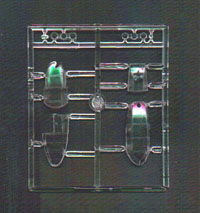 Amur 1946; scheme no. 5 is for a TU-2 of the Indonesian Air Force (Chinese Air Force markings are over-painted on this odd scheme), 1954; scheme no. 6 is for a TU-2 of the Soviet Air Force, built by funds raised by Moscow workers, 1945. This scheme is featured on the aircraft in the background of the box art. Strangely, the markings for the aircraft shown in the fore-ground of the box art is not included on the decal sheet. Amur 1946; scheme no. 5 is for a TU-2 of the Indonesian Air Force (Chinese Air Force markings are over-painted on this odd scheme), 1954; scheme no. 6 is for a TU-2 of the Soviet Air Force, built by funds raised by Moscow workers, 1945. This scheme is featured on the aircraft in the background of the box art. Strangely, the markings for the aircraft shown in the fore-ground of the box art is not included on the decal sheet. The instructions consist of a stapled booklet, 8 1/2" x 11" format, of eight pages. Page one gives the box art in black and white and the aircraft's history, in 4 languages including English. Page two is the parts tree drawings, followed by a parts listing (again in 4 languages). Pages three through five give us 10 assembly step drawings. The fuselage is broken down into seven pieces: sides, a rear bottom panel, bomb bay doors, front and rear fuselage top panels, and a upper tail cone panel. So careful fitting will be needed and probably a bit of putty work. The wings fit over two inner wing spars. This assembly may be a hairy fit also later, but will probably make for a very sturdy wing structure. 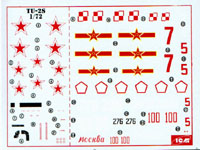 Pages six and seven are the marking and painting drawings. Page eight gives the paint code letter explanation chart (in four languages again). Pages six and seven are the marking and painting drawings. Page eight gives the paint code letter explanation chart (in four languages again). Conclusion I recommend this kit to those modelers amonst us who have a few kits with tricky assemblies under their belts. I picked this kit up at the IPMS 2001 National Convention, in Chicago. I got it from a vendor who let it go for a virtual song in the 12th hour of the four-day contest. It was a real bargain. Every once in a while a guy gets a bargain. | 

 




|
